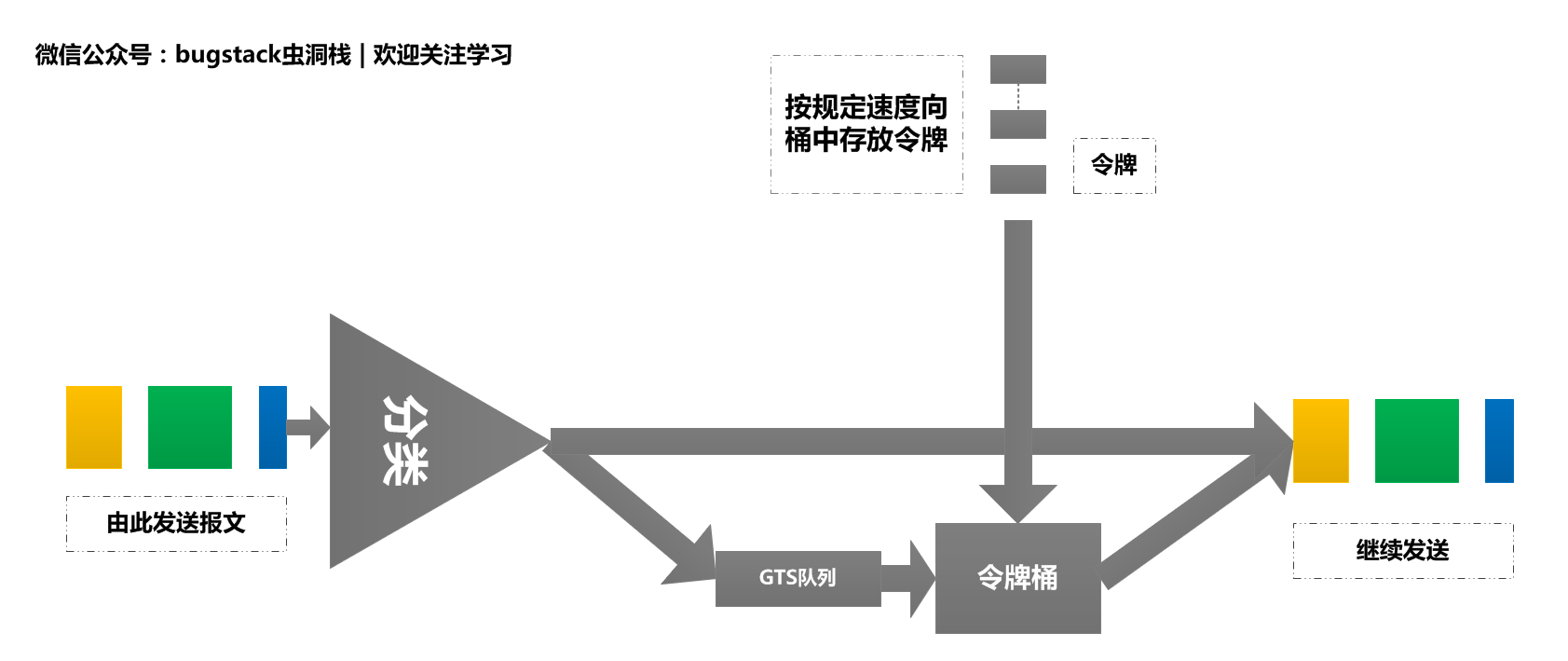-
Notifications
You must be signed in to change notification settings - Fork 3.8k
2019 08 27 netty案例,netty4.1中级拓展篇十二《Netty流量整形数据流速率控制分析与实战》
作者:小傅哥
博客:https://bugstack.cn - 原创系列专题
沉淀、分享、成长,让自己和他人都能有所收获!
你是否使用过某盘,在前几年我们使用的时候速度飞快,上传下载嗖嗖嗖。但是近年来只要不办会员,速度慢的像蜗牛,当然人家也得赚钱我们能理解。那么这样的限速是怎么实现的呢,我们这个案例使用Netty的流量整形进行限速传输,测试过程中当你把流量整形功能去掉后你就是年费VIP。
流量整形(Traffic Shaping)是一种主动调整流量输出速率的措施。一个典型应用是基于下游网络结点的TP指标来控制本地流量的输出。流量整形与流量监管的主要区别在于,流量整形对流量监管中需要丢弃的报文进行缓存——通常是将它们放入缓冲区或队列内,也称流量整形(Traffic Shaping,简称TS)。当令牌桶有足够的令牌时,再均匀的向外发送这些被缓存的报文。流量整形与流量监管的另一区别是,整形可能会增加延迟,而监管几乎不引入额外的延迟。
Netty中通过实现抽象类AbstractTrafficShapingHandler,提供了三个流量整形的类;GlobalTrafficShapingHandler、ChannelTrafficShapingHandler、GlobalChannelTrafficShapingHandler;
AbstractTrafficShapingHandler.java | 功能介绍
/**
* <p>AbstractTrafficShapingHandler allows to limit the global bandwidth
* (see {@link GlobalTrafficShapingHandler}) or per session
* bandwidth (see {@link ChannelTrafficShapingHandler}), as traffic shaping.
* It allows you to implement an almost real time monitoring of the bandwidth using
* the monitors from {@link TrafficCounter} that will call back every checkInterval
* the method doAccounting of this handler.</p>
*
* <p>If you want for any particular reasons to stop the monitoring (accounting) or to change
* the read/write limit or the check interval, several methods allow that for you:</p>
* <ul>
* <li><tt>configure</tt> allows you to change read or write limits, or the checkInterval</li>
* <li><tt>getTrafficCounter</tt> allows you to have access to the TrafficCounter and so to stop
* or start the monitoring, to change the checkInterval directly, or to have access to its values.</li>
* </ul>
*/
public abstract class AbstractTrafficShapingHandler extends ChannelDuplexHandler{...}AbstractTrafficShapingHandler允许限制全局的带宽(见GlobalTrafficShapingHandler)或者每个session的带宽(见ChannelTrafficShapingHandler)作为流量整形。 它允许你使用TrafficCounter来实现几乎实时的带宽监控,TrafficCounter会在每个检测间期(checkInterval)调用这个处理器的doAccounting方法。
如果你有任何特别的原因想要停止监控(计数)或者改变读写的限制或者改变检测间期(checkInterval),可以使用如下方法:
- configure:允许你改变读或写的限制,或者检测间期(checkInterval);
- getTrafficCounter:允许你获得TrafficCounter,并可以停止或启动监控,直接改变检测间期(checkInterval),或去访问它的值。
TrafficCounter:对读和写的字节进行计数以用于限制流量。 它会根据给定的检测间期周期性的计算统计入站和出站的流量,并会回调AbstractTrafficShapingHandler的doAccounting方法。 如果检测间期(checkInterval)是0,将不会进行计数并且统计只会在每次读或写操作时进行计算。
GlobalTrafficShapingHandler.java | 全局限制
/**
* <p>This implementation of the {@link AbstractTrafficShapingHandler} is for global
* traffic shaping, that is to say a global limitation of the bandwidth, whatever
* the number of opened channels.</p>
* <p>Note the index used in {@code OutboundBuffer.setUserDefinedWritability(index, boolean)} is <b>2</b>.</p>
*
* <p>The general use should be as follow:</p>
* <ul>
* <li><p>Create your unique GlobalTrafficShapingHandler like:</p>
* <p><tt>GlobalTrafficShapingHandler myHandler = new GlobalTrafficShapingHandler(executor);</tt></p>
* <p>The executor could be the underlying IO worker pool</p>
* <p><tt>pipeline.addLast(myHandler);</tt></p>
*
* <p><b>Note that this handler has a Pipeline Coverage of "all" which means only one such handler must be created
* and shared among all channels as the counter must be shared among all channels.</b></p>
*
* <p>Other arguments can be passed like write or read limitation (in bytes/s where 0 means no limitation)
* or the check interval (in millisecond) that represents the delay between two computations of the
* bandwidth and so the call back of the doAccounting method (0 means no accounting at all).</p>
*
* <p>A value of 0 means no accounting for checkInterval. If you need traffic shaping but no such accounting,
* it is recommended to set a positive value, even if it is high since the precision of the
* Traffic Shaping depends on the period where the traffic is computed. The highest the interval,
* the less precise the traffic shaping will be. It is suggested as higher value something close
* to 5 or 10 minutes.</p>
*
* <p>maxTimeToWait, by default set to 15s, allows to specify an upper bound of time shaping.</p>
* </li>
* <li>In your handler, you should consider to use the {@code channel.isWritable()} and
* {@code channelWritabilityChanged(ctx)} to handle writability, or through
* {@code future.addListener(new GenericFutureListener())} on the future returned by
* {@code ctx.write()}.</li>
* <li><p>You shall also consider to have object size in read or write operations relatively adapted to
* the bandwidth you required: for instance having 10 MB objects for 10KB/s will lead to burst effect,
* while having 100 KB objects for 1 MB/s should be smoothly handle by this TrafficShaping handler.</p></li>
* <li><p>Some configuration methods will be taken as best effort, meaning
* that all already scheduled traffics will not be
* changed, but only applied to new traffics.</p>
* So the expected usage of those methods are to be used not too often,
* accordingly to the traffic shaping configuration.</li>
* </ul>
*
* Be sure to call {@link #release()} once this handler is not needed anymore to release all internal resources.
* This will not shutdown the {@link EventExecutor} as it may be shared, so you need to do this by your own.
*/
@Sharable
public class GlobalTrafficShapingHandler extends AbstractTrafficShapingHandler {}这实现了AbstractTrafficShapingHandler的全局流量整形,也就是说它限制了全局的带宽,无论开启了几个channel。 注意『 OutboundBuffer.setUserDefinedWritability(index, boolean)』中索引使用’2’。
一般用途如下: 创建一个唯一的GlobalTrafficShapingHandler
GlobalTrafficShapingHandler myHandler = new GlobalTrafficShapingHandler(executor);
pipeline.addLast(myHandler);executor可以是底层的IO工作池
注意,这个处理器是覆盖所有管道的,这意味着只有一个处理器对象会被创建并且作为所有channel间共享的计数器,它必须于所有的channel共享。 所有你可以见到,该类的定义上面有个@Sharable注解。
在你的处理器中,你需要考虑使用『channel.isWritable()』和『channelWritabilityChanged(ctx)』来处理可写性,或通过在ctx.write()返回的future上注册listener来实现。
你还需要考虑读或写操作对象的大小需要和你要求的带宽相对应:比如,你将一个10M大小的对象用于10KB/s的带宽将会导致爆发效果,若你将100KB大小的对象用于在1M/s带宽那么将会被流量整形处理器平滑处理。
一旦不在需要这个处理器时请确保调用『release()』以释放所有内部的资源。这不会关闭EventExecutor,因为它可能是共享的,所以这需要你自己做。
GlobalTrafficShapingHandler中持有一个Channel的哈希表,用于存储当前应用所有的Channel:
private final ConcurrentMap<Integer, PerChannel> channelQueues = PlatformDependent.newConcurrentHashMap();key为Channel的hashCode;value是一个PerChannel对象。 PerChannel对象中维护有该Channel的待发送数据的消息队列(ArrayDeque messagesQueue)。
ChannelTrafficShapingHandler.java | 功能介绍
/**
* <p>This implementation of the {@link AbstractTrafficShapingHandler} is for channel
* traffic shaping, that is to say a per channel limitation of the bandwidth.</p>
* <p>Note the index used in {@code OutboundBuffer.setUserDefinedWritability(index, boolean)} is <b>1</b>.</p>
*
* <p>The general use should be as follow:</p>
* <ul>
* <li><p>Add in your pipeline a new ChannelTrafficShapingHandler.</p>
* <p><tt>ChannelTrafficShapingHandler myHandler = new ChannelTrafficShapingHandler();</tt></p>
* <p><tt>pipeline.addLast(myHandler);</tt></p>
*
* <p><b>Note that this handler has a Pipeline Coverage of "one" which means a new handler must be created
* for each new channel as the counter cannot be shared among all channels.</b>.</p>
*
* <p>Other arguments can be passed like write or read limitation (in bytes/s where 0 means no limitation)
* or the check interval (in millisecond) that represents the delay between two computations of the
* bandwidth and so the call back of the doAccounting method (0 means no accounting at all).</p>
*
* <p>A value of 0 means no accounting for checkInterval. If you need traffic shaping but no such accounting,
* it is recommended to set a positive value, even if it is high since the precision of the
* Traffic Shaping depends on the period where the traffic is computed. The highest the interval,
* the less precise the traffic shaping will be. It is suggested as higher value something close
* to 5 or 10 minutes.</p>
*
* <p>maxTimeToWait, by default set to 15s, allows to specify an upper bound of time shaping.</p>
* </li>
* <li>In your handler, you should consider to use the {@code channel.isWritable()} and
* {@code channelWritabilityChanged(ctx)} to handle writability, or through
* {@code future.addListener(new GenericFutureListener())} on the future returned by
* {@code ctx.write()}.</li>
* <li><p>You shall also consider to have object size in read or write operations relatively adapted to
* the bandwidth you required: for instance having 10 MB objects for 10KB/s will lead to burst effect,
* while having 100 KB objects for 1 MB/s should be smoothly handle by this TrafficShaping handler.</p></li>
* <li><p>Some configuration methods will be taken as best effort, meaning
* that all already scheduled traffics will not be
* changed, but only applied to new traffics.</p>
* <p>So the expected usage of those methods are to be used not too often,
* accordingly to the traffic shaping configuration.</p></li>
* </ul>
*/
public class ChannelTrafficShapingHandler extends AbstractTrafficShapingHandler {...}ChannelTrafficShapingHandler是针对单个Channel的流量整形,和GlobalTrafficShapingHandler的思想是一样的。只是实现中没有对全局概念的检测,仅检测了当前这个Channel的数据。 这里就不再赘述了。
GlobalChannelTrafficShapingHandler.java | 功能介绍
/**
* This implementation of the {@link AbstractTrafficShapingHandler} is for global
* and per channel traffic shaping, that is to say a global limitation of the bandwidth, whatever
* the number of opened channels and a per channel limitation of the bandwidth.<br><br>
* This version shall not be in the same pipeline than other TrafficShapingHandler.<br><br>
*
* The general use should be as follow:<br>
* <ul>
* <li>Create your unique GlobalChannelTrafficShapingHandler like:<br><br>
* <tt>GlobalChannelTrafficShapingHandler myHandler = new GlobalChannelTrafficShapingHandler(executor);</tt><br><br>
* The executor could be the underlying IO worker pool<br>
* <tt>pipeline.addLast(myHandler);</tt><br><br>
*
* <b>Note that this handler has a Pipeline Coverage of "all" which means only one such handler must be created
* and shared among all channels as the counter must be shared among all channels.</b><br><br>
*
* Other arguments can be passed like write or read limitation (in bytes/s where 0 means no limitation)
* or the check interval (in millisecond) that represents the delay between two computations of the
* bandwidth and so the call back of the doAccounting method (0 means no accounting at all).<br>
* Note that as this is a fusion of both Global and Channel Traffic Shaping, limits are in 2 sets,
* respectively Global and Channel.<br><br>
*
* A value of 0 means no accounting for checkInterval. If you need traffic shaping but no such accounting,
* it is recommended to set a positive value, even if it is high since the precision of the
* Traffic Shaping depends on the period where the traffic is computed. The highest the interval,
* the less precise the traffic shaping will be. It is suggested as higher value something close
* to 5 or 10 minutes.<br><br>
*
* maxTimeToWait, by default set to 15s, allows to specify an upper bound of time shaping.<br><br>
* </li>
* <li>In your handler, you should consider to use the {@code channel.isWritable()} and
* {@code channelWritabilityChanged(ctx)} to handle writability, or through
* {@code future.addListener(new GenericFutureListener())} on the future returned by
* {@code ctx.write()}.</li>
* <li>You shall also consider to have object size in read or write operations relatively adapted to
* the bandwidth you required: for instance having 10 MB objects for 10KB/s will lead to burst effect,
* while having 100 KB objects for 1 MB/s should be smoothly handle by this TrafficShaping handler.<br><br></li>
* <li>Some configuration methods will be taken as best effort, meaning
* that all already scheduled traffics will not be
* changed, but only applied to new traffics.<br>
* So the expected usage of those methods are to be used not too often,
* accordingly to the traffic shaping configuration.</li>
* </ul><br>
*
* Be sure to call {@link #release()} once this handler is not needed anymore to release all internal resources.
* This will not shutdown the {@link EventExecutor} as it may be shared, so you need to do this by your own.
*/
@Sharable
public class GlobalChannelTrafficShapingHandler extends AbstractTrafficShapingHandler {...}相比于GlobalTrafficShapingHandler增加了一个误差概念,以平衡各个Channel间的读/写操作。也就是说,使得各个Channel间的读/写操作尽量均衡。比如,尽量避免不同Channel的大数据包都延迟近乎一样的是时间再操作,以及如果小数据包在一个大数据包后才发送,则减少该小数据包的延迟发送时间等。。
- jdk1.8【jdk1.7以下只能部分支持netty】
- Netty4.1.36.Final【netty3.x 4.x 5每次的变化较大,接口类名也随着变化】
itstack-demo-netty-2-12
└── src
├── main
│ └── java
│ └── org.itstack.demo.netty
│ ├── client
│ │ ├── MyChannelInitializer.java
│ │ ├── MyClientHandler.java
│ │ └── NettyClient.java
│ └── server
│ ├── common
│ │ └── MyServerCommonHandler.java
│ ├── MyChannelInitializer.java
│ ├── MyServerHandler.java
│ └── NettyServer.java
│
└── test
└── java
└── org.itstack.demo.test
└── ApiTest.java部分重点代码块讲解,获取全部代码,关注公众号:bugstack虫洞栈 | 回复netty源码
client/MyChannelInitializer.java | 增加Channel流量整形配置,速率设置为10bytes/s
/**
* 虫洞栈:https://bugstack.cn
* 公众号:bugstack虫洞栈 {获取学习源码}
* Create by fuzhengwei on 2019
*/
public class MyChannelInitializer extends ChannelInitializer<SocketChannel> {
@Override
protected void initChannel(SocketChannel channel) throws Exception {
//流量整形
channel.pipeline().addLast(new ChannelTrafficShapingHandler(10, 10));
// 基于换行符号
channel.pipeline().addLast(new LineBasedFrameDecoder(1024));
// 解码转String,注意调整自己的编码格式GBK、UTF-8
channel.pipeline().addLast(new StringDecoder(Charset.forName("GBK")));
// 解码转String,注意调整自己的编码格式GBK、UTF-8
channel.pipeline().addLast(new StringEncoder(Charset.forName("GBK")));
// 在管道中添加我们自己的接收数据实现方法
channel.pipeline().addLast(new MyClientHandler());
}
}server/common/MyServerCommonHandler.java | 提供抽象类,监控发送速率以及获取发送状态
/**
* 虫洞栈:https://bugstack.cn
* 公众号:bugstack虫洞栈 | 欢迎关注并获取专题&源码
* Create by fuzhengwei on 2019
*/
public abstract class MyServerCommonHandler extends SimpleChannelInboundHandler<String> {
protected boolean sentFlag;
private Runnable counterTask;
private AtomicLong consumeMsgLength = new AtomicLong();
private long priorProgress;
@Override
public void handlerAdded(ChannelHandlerContext ctx) throws Exception {
counterTask = () -> {
while (true) {
try {
Thread.sleep(500);
long length = consumeMsgLength.getAndSet(0);
if (0 == length) continue;
System.out.println("数据发送速率(KB/S):" + length);
} catch (InterruptedException ignored) {
}
}
};
super.handlerAdded(ctx);
}
@Override
public void channelActive(ChannelHandlerContext ctx) throws Exception {
sendData(ctx);
//启动监控线程
new Thread(counterTask).start();
}
protected abstract void sendData(ChannelHandlerContext ctx);
protected ChannelProgressivePromise getChannelProgressivePromise(ChannelHandlerContext ctx, Consumer<ChannelProgressiveFuture> completedAction) {
ChannelProgressivePromise channelProgressivePromise = ctx.newProgressivePromise();
channelProgressivePromise.addListener(new ChannelProgressiveFutureListener() {
@Override
public void operationProgressed(ChannelProgressiveFuture future, long progress, long total) throws Exception {
consumeMsgLength.addAndGet(progress - priorProgress);
priorProgress = progress;
}
@Override
public void operationComplete(ChannelProgressiveFuture future) throws Exception {
sentFlag = false;
if (future.isSuccess()) {
System.out.println("微信公众号:bugstack虫洞栈 | 提醒,消息发送成功!");
priorProgress -= 10;
Optional.ofNullable(completedAction).ifPresent(action -> action.accept(future));
} else {
System.out.println("微信公众号:bugstack虫洞栈 | 提醒,消息发送失败!");
future.cause().printStackTrace();
}
}
});
return channelProgressivePromise;
}
@Override
protected void channelRead0(ChannelHandlerContext ctx, String msg) throws Exception {
System.out.println("微信公众号:bugstack虫洞栈 | NettyServer接收到消息:" + msg);
}
}server/MyChannelInitializer.java | 增加全局流量整形配置,速率设置为10bytes/s
/**
* 虫洞栈:https://bugstack.cn
* 公众号:bugstack虫洞栈 | 欢迎关注并获取专题&源码
* Create by fuzhengwei on 2019
*/
public class MyChannelInitializer extends ChannelInitializer<SocketChannel> {
@Override
protected void initChannel(SocketChannel channel) {
// 基于换行符号
channel.pipeline().addLast(new LineBasedFrameDecoder(1024));
// 流量整形;writeLimit/readLimit{0 or a limit in bytes/s}
channel.pipeline().addLast(new GlobalTrafficShapingHandler(channel.eventLoop().parent(), 10, 10));
// 解码转String,注意调整自己的编码格式GBK、UTF-8
channel.pipeline().addLast(new StringDecoder(Charset.forName("GBK")));
// 解码转String,注意调整自己的编码格式GBK、UTF-8
channel.pipeline().addLast(new StringEncoder(Charset.forName("GBK")));
// 在管道中添加我们自己的接收数据实现方法
channel.pipeline().addLast(new MyServerHandler());
}
}server/MyServerHandler.java | 处理消息验证是否可以发送ctx.channel().isWritable()
/**
* 虫洞栈:https://bugstack.cn
* 公众号:bugstack虫洞栈 | 欢迎关注并获取专题&源码
* Create by fuzhengwei on 2019
*/
public class MyServerHandler extends MyServerCommonHandler {
@Override
protected void sendData(ChannelHandlerContext ctx) {
sentFlag = true;
ctx.writeAndFlush( "111111111122222222223333333333\r\n", getChannelProgressivePromise(ctx, new Consumer<ChannelProgressiveFuture>() {
@Override
public void accept(ChannelProgressiveFuture channelProgressiveFuture) {
if (ctx.channel().isWritable() && !sentFlag) {
sendData(ctx);
}
}
}));
}
}启动服务端NettyServer | 可以看到速率已经被限制
itstack-demo-netty server start done. {关注公众号:bugstack虫洞栈 | 获取专题案例源码}
微信公众号:bugstack虫洞栈 | 提醒,消息发送成功!
数据发送速率(KB/S):32
微信公众号:bugstack虫洞栈 | 提醒,消息发送成功!
数据发送速率(KB/S):10
微信公众号:bugstack虫洞栈 | NettyServer接收到消息:876d251b-aba8-481a-81d0-e123a4c42214
微信公众号:bugstack虫洞栈 | 提醒,消息发送成功!
数据发送速率(KB/S):10
微信公众号:bugstack虫洞栈 | NettyServer接收到消息:250d53fb-acc3-4390-b5c5-a660577fff6f
微信公众号:bugstack虫洞栈 | 提醒,消息发送成功!
数据发送速率(KB/S):10
微信公众号:bugstack虫洞栈 | NettyServer接收到消息:89cad8a0-8e5b-44ef-812b-39c4b2d2e0fb
微信公众号:bugstack虫洞栈 | 提醒,消息发送成功!
数据发送速率(KB/S):10
微信公众号:bugstack虫洞栈 | NettyServer接收到消息:e951ca01-a583-4c20-b884-5c272b1cc7a4
微信公众号:bugstack虫洞栈 | 提醒,消息发送成功!
数据发送速率(KB/S):10
微信公众号:bugstack虫洞栈 | NettyServer接收到消息:4b13d77c-188f-4613-9cd9-94a2a7751932
微信公众号:bugstack虫洞栈 | 提醒,消息发送成功!
数据发送速率(KB/S):10
微信公众号:bugstack虫洞栈 | 提醒,消息发送成功!
微信公众号:bugstack虫洞栈 | NettyServer接收到消息:fdc5378c-a594-4be8-885d-4caa7ecccd82
数据发送速率(KB/S):10
Process finished with exit code -1启动客户端NettyClient | 可以看到速率已经被限制
itstack-demo-netty client start done. {关注公众号:bugstack虫洞栈 | 获取专题案例源码}
微信公众号:bugstack虫洞栈 | NettyClient接收到消息:111111111122222222223333333333 length:30
微信公众号:bugstack虫洞栈 | NettyClient接收到消息:111111111122222222223333333333 length:30
微信公众号:bugstack虫洞栈 | NettyClient接收到消息:111111111122222222223333333333 length:30
微信公众号:bugstack虫洞栈 | NettyClient接收到消息:111111111122222222223333333333 length:30
微信公众号:bugstack虫洞栈 | NettyClient接收到消息:111111111122222222223333333333 length:30
微信公众号:bugstack虫洞栈 | NettyClient接收到消息:111111111122222222223333333333 length:30
微信公众号:bugstack虫洞栈 | NettyClient接收到消息:111111111122222222223333333333 length:30
微信公众号:bugstack虫洞栈 | NettyClient接收到消息:111111111122222222223333333333 length:30
Process finished with exit code -1上一篇:netty案例,netty4.1中级拓展篇十一《Netty基于ChunkedStream数据流切块传输》
下一篇:netty案例,netty4.1中级拓展篇十三《Netty基于SSL实现信息传输过程中双向加密验证》
微信搜索「bugstack虫洞栈」公众号,关注后回复「Netty专题案例」获取本文源码&更多原创专题案例!
小傅哥(微信:fustack),公众号:bugstack虫洞栈 | bugstack.cn - 沉淀、分享、成长,让自己和他人都能有所收获!
🌏 知识星球:码农会锁

实战项目:「DDD+RPC分布式抽奖系统」、专属小册、问题解答、简历指导、架构图稿、视频课程
🐲 头条
-
💥
🎁 Lottery 抽奖系统- 基于领域驱动设计的四层架构的互联网分布式开发实践 -
小傅哥的《重学 Java 设计模式》- 全书彩印、重绘类图、添加内容 -
⭐小傅哥的《Java 面经手册》- 全书5章29节,417页11.5万字,完稿&发版 -
小傅哥的《手撸 Spring》- 通过带着读者手写简化版 Spring 框架,了解 Spring 核心原理 -
🌈小傅哥的《SpringBoot 中间件设计和开发》- 小册16个中间件开发30个代码库
⛳ 目录
💋 精选
🐾 友链
建立本开源项目的初衷是基于个人学习与工作中对 Java 相关技术栈的总结记录,在这里也希望能帮助一些在学习 Java 过程中遇到问题的小伙伴,如果您需要转载本仓库的一些文章到自己的博客,请按照以下格式注明出处,谢谢合作。
作者:小傅哥
链接:https://bugstack.cn
来源:bugstack虫洞栈2021年10月24日,小傅哥 的文章全部开源到代码库 CodeGuide 中,与同好同行,一起进步,共同维护。
这里我提供 3 种方式:
-
提出
Issue:在 Issue 中指出你觉得需要改进/完善的地方(能够独立解决的话,可以在提出 Issue 后再提交PR)。 -
处理
Issue: 帮忙处理一些待处理的Issue。 -
提交
PR: 对于错别字/笔误这类问题可以直接提交PR,无需提交Issue确认。
详细参考:CodeGuide 贡献指南 - 非常感谢你的支持,这里会留下你的足迹
- 加群交流 本群的宗旨是给大家提供一个良好的技术学习交流平台,所以杜绝一切广告!由于微信群人满 100 之后无法加入,请扫描下方二维码先添加作者 “小傅哥” 微信(fustack),备注:加群。

- 公众号(bugstack虫洞栈) - 沉淀、分享、成长,专注于原创专题案例,以最易学习编程的方式分享知识,让自己和他人都能有所收获。

感谢以下人员对本仓库做出的贡献或者对小傅哥的赞赏,当然不仅仅只有这些贡献者,这里就不一一列举了。如果你希望被添加到这个名单中,并且提交过 Issue 或者 PR,请与我联系。
